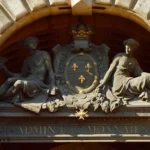Musée d’Orsay: Step into a world of artistic brilliance and Belle Époque charm in the heart of Paris. Housed in a stunning Beaux-Arts railway station, this iconic museum offers a captivating journey through the vibrant colors of Impressionism, the elegant extravagance of the Belle Époque, and the innovative sculptures of the late 19th and early 20th centuries. Whether you’re an art aficionado or a curious traveler, Musée d’Orsay promises an unforgettable experience filled with iconic masterpieces, hidden gems, and fascinating stories. Let this guide be your companion as you explore the museum’s treasures and uncover the secrets of this Parisian landmark.
Orsay’s Iconic Impressionists
Welcome to the heart of Impressionism! The Musée d’Orsay houses the world’s most extensive collection of Impressionist and Post-Impressionist masterpieces. Wander through galleries filled with sunlight and color, where you’ll encounter iconic works by Monet, Renoir, Degas, and Pissarro. Don’t miss Monet’s “Water Lilies,” Renoir’s “Bal du moulin de la Galette,” or Degas’ graceful ballerinas. These paintings revolutionized the art world and continue to captivate visitors with their vibrant brushstrokes and fleeting moments of beauty.
As you explore, you’ll discover the evolution of Impressionism. Follow the movement’s progression from its early days of capturing natural light and outdoor scenes to the more experimental techniques of Post-Impressionism. You’ll encounter the bold colors of Van Gogh’s “Starry Night over the Rhone,” the pointillist dots of Seurat’s “A Sunday Afternoon on the Island of La Grande Jatte,” and the evocative symbolism of Gauguin’s Tahitian paintings. Each artist offers a unique perspective and a window into the artistic innovations of the late 19th century.
The Orsay’s collection also includes works by other notable artists of the period, such as Manet, Sisley, Caillebotte, and Morisot. Their paintings depict Parisian life, landscapes, and portraits with a fresh and modern sensibility. Take your time to appreciate the details, the play of light, and the emotions captured in each artwork. Whether you’re an art aficionado or a casual observer, the Impressionist galleries of the Musée d’Orsay are sure to leave a lasting impression.
Belle Époque: Beauty & Excess
Step back in time to the Belle Époque, a period of cultural flourishing and extravagant indulgence in late 19th-century France. The Musée d’Orsay showcases the art and decorative arts of this era, capturing its elegance, optimism, and sense of joie de vivre. Admire the intricate craftsmanship of Art Nouveau furniture, the delicate lines of jewelry, and the exquisite details of fashion. You’ll be transported to a world of salons, cabarets, and grand exhibitions, where beauty and luxury reigned supreme.
The Belle Époque was a time of rapid social change and technological innovation. The Orsay’s collection reflects this dynamism, showcasing paintings, sculptures, and photographs that depict the new urban landscapes, the rise of leisure activities, and the changing roles of women. Explore the galleries dedicated to the works of artists like Toulouse-Lautrec, who captured the vibrant nightlife of Montmartre, or the photographs of Nadar, who immortalized the faces of Parisian society. You’ll gain a deeper understanding of the Belle Époque as a time of both beauty and contradictions.
Don’t miss the opportunity to visit the reconstructed Belle Époque apartments on the top floor of the museum. These lavishly decorated rooms offer a glimpse into the lives of the wealthy and fashionable during this era. Marvel at the opulent furnishings, the intricate woodwork, and the stunning views of Paris. The Belle Époque apartments are a testament to the era’s obsession with beauty, luxury, and the pursuit of pleasure.
Orsay’s Architectural Splendor
The Musée d’Orsay itself is a work of art. Housed in a former Beaux-Arts railway station, the building’s grand architecture is a sight to behold. As you enter, you’ll be greeted by a soaring glass roof that floods the central nave with natural light. The ornate ironwork, elegant arches, and intricate details of the building’s façade are a testament to the Belle Époque’s architectural grandeur.
Take a moment to appreciate the clever design of the museum’s interior spaces. The galleries are arranged in a way that allows you to follow the chronological progression of art movements, from Academic art to Impressionism, Post-Impressionism, and beyond. The museum’s layout is intuitive and easy to navigate, ensuring a seamless and enjoyable visitor experience.
Don’t forget to look up! The Orsay’s ceilings are adorned with intricate frescoes and decorative motifs. The grand clock on the museum’s façade is a reminder of its railway station past. The architectural details of the building add another layer of beauty and intrigue to your visit. Whether you’re an art lover or an architecture enthusiast, the Musée d’Orsay is sure to impress.
From Train Station to Art Haven
The Musée d’Orsay has a fascinating history. It was originally built as a railway station, the Gare d’Orsay, in 1900 for the World’s Fair. The station’s grand architecture and innovative design were meant to impress visitors from around the globe. However, as trains became longer, the platforms became too short, and the station eventually fell into disuse.
In the 1970s, the French government decided to repurpose the building into a museum dedicated to the arts of the late 19th and early 20th centuries. The transformation was a massive undertaking, but the result is a stunning museum that seamlessly blends the old and the new. The original station’s architecture has been beautifully preserved, while modern galleries have been added to showcase the art collection.
As you wander through the museum, you’ll find remnants of the station’s past, such as the original clocks, the ornate ironwork, and the grand central nave. These elements add a unique charm to the museum and remind visitors of its fascinating history. The transformation of the Gare d’Orsay into the Musée d’Orsay is a testament to the power of adaptive reuse and the enduring legacy of Belle Époque architecture.
Orsay’s Sculpture Collection
The Musée d’Orsay is not just about paintings. It also houses a remarkable collection of sculptures from the late 19th and early 20th centuries. As you explore the museum’s galleries, you’ll encounter a diverse range of sculptures, from the classical elegance of Rodin’s “The Thinker” to the expressive forms of Camille Claudel’s “The Waltz.”
The sculptures are displayed throughout the museum, both in dedicated galleries and interspersed among the paintings. This creates a dynamic and engaging visitor experience, allowing you to appreciate the sculptures in context with the other art forms of the period. The Orsay’s collection includes works by some of the most celebrated sculptors of the time, including Rodin, Claudel, Maillol, and Carpeaux.
Take your time to admire the intricate details, the textures, and the emotions captured in each sculpture. The Orsay’s collection offers a comprehensive overview of the evolution of sculpture during this period, from the academic tradition to the more avant-garde styles of the early 20th century. Whether you’re a sculpture enthusiast or simply appreciate the beauty of three-dimensional art, the Orsay’s collection is sure to inspire and delight.
Café Campana: Dining with a View
Need a break from all the art? Head to Café Campana, located on the top floor of the Musée d’Orsay. This elegant café offers a delightful dining experience with breathtaking views of Paris. Enjoy a cup of coffee, a light lunch, or a pastry while admiring the city’s iconic landmarks, including the Sacré-Coeur Basilica and the Eiffel Tower.
The café is named after its designer, Brazilian architect Campana, who created a unique and stylish space that complements the museum’s Belle Époque architecture. The café’s interior features a mix of modern and vintage elements, with comfortable seating, warm lighting, and a relaxed atmosphere.
Café Campana is the perfect place to refuel and recharge after exploring the museum’s extensive collection. The menu features a selection of French and international dishes, made with fresh, seasonal ingredients. Whether you’re looking for a quick bite or a leisurely meal, Café Campana is a must-visit for any visitor to the Musée d’Orsay.
Orsay for Families: Kid-Friendly Tips
Visiting a museum with children can be a rewarding experience for everyone. The Musée d’Orsay offers several resources to make your family’s visit enjoyable and educational. Pick up a family guide at the information desk, which includes fun activities and games to keep your children engaged.
The museum also offers special workshops and tours designed for families. These interactive programs introduce children to the world of art through hands-on activities, storytelling, and creative exploration. Check the museum’s website or inquire at the information desk for the latest schedule of family programs.
Remember to take breaks and allow your children to explore at their own pace. The Orsay has several benches and seating areas where you can rest and recharge. The museum also has a dedicated family room, where you can relax, nurse, or change diapers. With a little planning and preparation, your family can have a memorable and enriching experience at the Musée d’Orsay.
Orsay’s Hidden Gems: Beyond the Famous
While the Musée d’Orsay is renowned for its Impressionist collection, it also houses many other artistic treasures waiting to be discovered. Venture beyond the well-trodden paths and explore the museum’s lesser-known galleries. You might stumble upon a hidden masterpiece, a forgotten artist, or a fascinating story.
One of the museum’s hidden gems is the collection of Symbolist art. This enigmatic movement explored themes of dreams, mythology, and the subconscious. You’ll find works by artists like Gustave Moreau, Odilon Redon, and Pierre Puvis de Chavannes, who created ethereal and evocative paintings that transport you to another world.
Another hidden gem is the collection of decorative arts. Explore the galleries dedicated to Art Nouveau furniture, jewelry, and ceramics. You’ll be amazed by the intricate craftsmanship, the innovative designs, and the exquisite beauty of these objects. The Orsay’s collection of decorative arts offers a glimpse into the artistic trends and tastes of the late 19th and early 20th centuries.
Planning Your Orsay Visit: Tickets & Tips
To make the most of your visit to the Musée d’Orsay, it’s essential to plan. Purchase your tickets online in advance to avoid long queues, especially during peak season. Consider buying a combined ticket that includes admission to other Parisian museums, such as the Louvre or the Musée de l’Orangerie.
Choose the right time to visit. The museum can get crowded, especially on weekends and holidays. If possible, visit on a weekday morning or late afternoon to avoid the crowds. Consider taking a guided tour to gain deeper insights into the art and history of the museum.
Wear comfortable shoes, as you’ll be doing a lot of walking. Bring a water bottle and snacks, as there are limited food options inside the museum. Leave large bags and backpacks at the coat check, as they are not allowed in the galleries. Most importantly, take your time and enjoy the experience. The Musée d’Orsay is a treasure trove of art and history, and there’s something for everyone to discover.
Orsay After Dark: Evening Events
The Musée d’Orsay isn’t just a daytime destination. Experience the magic of the museum after hours by attending one of its special evening events. The museum regularly hosts concerts, lectures, and film screenings, often related to the current exhibitions.
The Orsay’s evening events offer a unique opportunity to see the museum in a different light, away from the daytime crowds. The atmosphere is more intimate and relaxed, allowing you to fully immerse yourself in the art and culture. Check the museum’s website or social media for upcoming events and to purchase tickets.
Imagine listening to a classical concert in the museum’s grand nave, surrounded by masterpieces of Impressionism. Or attending a lecture on the Belle Époque, followed by a film screening in the museum’s auditorium. The Orsay’s evening events are a must-do for any art lover or culture vulture visiting Paris.
Orsay’s Gift Shop: Souvenirs & Treasures
Before you leave the Musée d’Orsay, be sure to visit the museum’s gift shop. You’ll find a wide selection of souvenirs, books, posters, and other items inspired by the museum’s collection.
The gift shop is a great place to find unique gifts for friends and family, or to treat yourself to a special memento of your visit. Browse the shelves for books on art history, exhibition catalogs, or novels set in the Belle Époque. You’ll also find a variety of postcards, posters, and prints featuring your favorite artworks.
For those looking for something a little more special, the gift shop also offers a selection of jewelry, accessories, and home décor items inspired by the museum’s collection. You’ll find Art Nouveau-inspired necklaces, Impressionist-themed scarves, and even replicas of famous sculptures. The Orsay’s gift shop is a treasure trove of unique and beautiful items that capture the spirit of the museum.
Orsay’s Neighborhood: Saint-Germain-des-Prés
After your visit to the Musée d’Orsay, take some time to explore the surrounding neighborhood of Saint-Germain-des-Prés. This charming district is known for its literary and artistic heritage, as well as its chic boutiques, cafes, and restaurants.
Stroll along the narrow streets lined with historic buildings and discover hidden courtyards, art galleries, and antique shops. Stop for a coffee or a pastry at one of the many charming cafes, or browse the latest fashions in the designer boutiques.
Saint-Germain-des-Prés is also home to several notable landmarks, including the Église de Saint-Germain-des-Prés, one of the oldest churches in Paris, and the Deux Magots and Café de Flore, famous literary cafes frequented by the likes of Hemingway, Sartre, and Picasso. The neighborhood’s rich history and vibrant atmosphere make it a must-visit for any traveler to Paris.











